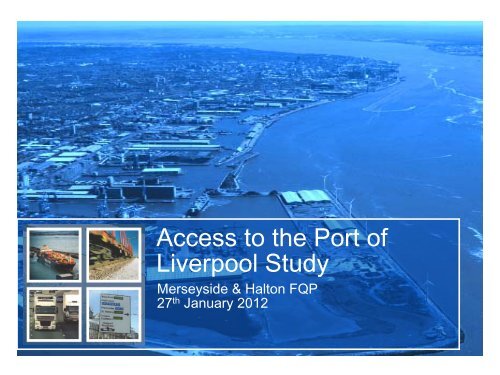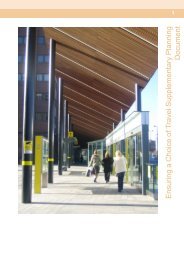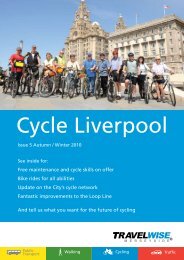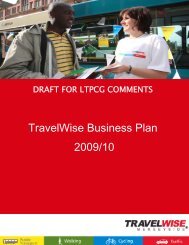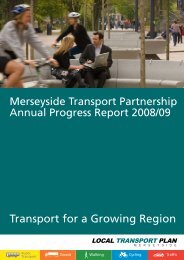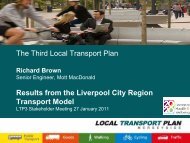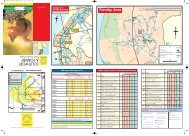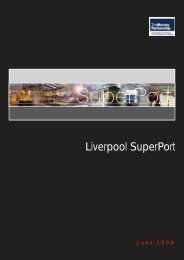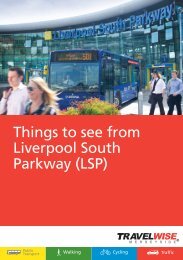Access to the Port of Liverpool Study - the TravelWise Merseyside ...
Access to the Port of Liverpool Study - the TravelWise Merseyside ...
Access to the Port of Liverpool Study - the TravelWise Merseyside ...
Create successful ePaper yourself
Turn your PDF publications into a flip-book with our unique Google optimized e-Paper software.
<strong>Access</strong> <strong>to</strong> <strong>the</strong> <strong>Port</strong> <strong>of</strong><br />
<strong>Liverpool</strong> <strong>Study</strong><br />
<strong>Merseyside</strong> & Hal<strong>to</strong>n FQP<br />
27 th January 2012
Overview <strong>of</strong> <strong>the</strong> <strong>Study</strong><br />
• Identified as priority study for <strong>the</strong> North West Region<br />
• Jointly Funded by DfT and Regional Partners<br />
• <strong>Port</strong> <strong>of</strong> <strong>Liverpool</strong> = major driver for growth – <strong>of</strong> regional and national<br />
importance<br />
• Major growth proposals – Mersey <strong>Port</strong>s Master Plan<br />
• Constrained transport network<br />
• Need for a clear access strategy<br />
• Drive for more sustainable forms <strong>of</strong> access
Key Questions <strong>to</strong> Address<br />
1. How is <strong>the</strong> port forecast <strong>to</strong> grow in <strong>the</strong> future?<br />
2. What are <strong>the</strong> implications <strong>of</strong> this growth for <strong>the</strong> local transport network?<br />
3. What potential is <strong>the</strong>re for modal shift?<br />
4. What are <strong>the</strong> transport access options for accommodating this growth?
<strong>Study</strong> Area and Existing<br />
<strong>Access</strong> Arrangements
<strong>Study</strong> Area:<br />
• Primary focus on <strong>Liverpool</strong> Docks Area:<br />
– Seaforth Container Terminal<br />
– <strong>to</strong><br />
– Sandon Half Tide Dock
Wider Context<br />
Also considered role <strong>of</strong> wider Mersey <strong>Port</strong>s area – Manchester Ship Canal
Current <strong>Port</strong> <strong>Access</strong> Arrangements:<br />
Highways<br />
1. Seaforth Dock Gate<br />
2. Strand Rd Dock Gate<br />
3. Seatruck Dock Gate<br />
4. Huskisson Dock Gate<br />
• O<strong>the</strong>r access points on Regent Road<br />
from Millers Bridge
Key <strong>Port</strong> <strong>Access</strong> Routes<br />
<strong>Access</strong> Routes:<br />
A5036 (Dunnings<br />
Bridge Rd)<br />
A5058 / A580 (Millers<br />
Bridge, Balliol Road,<br />
Breeze Hill, Queens<br />
Drive / East Lancs Rd)<br />
A565 (Derby Road)
Rail Freight<br />
WCML<br />
<strong>Port</strong><br />
Freight only branch<br />
Olive Mount Chord<br />
Chat Moss (Main Line)<br />
WCML<br />
Fiddler’s Ferry Power Station
Waterway and Coastal / Short Sea Shipping<br />
• Manchester Ship Canal can accommodate large<br />
seagoing vessels<br />
• Existing regular container barge service between<br />
Seaforth and Irlam<br />
• Grain also shipped up <strong>the</strong> MSC <strong>to</strong> Trafford Park<br />
• Plans identified in <strong>the</strong> Mersey <strong>Port</strong>s Master Plan<br />
• Well established scheduled coastal and short sea unit<br />
load short sea shipping links with:<br />
• Clyde<br />
• Belfast<br />
• Dublin<br />
• Iberia<br />
• Mediterranean
Findings <strong>of</strong> <strong>the</strong> <strong>Study</strong>:<br />
Answers <strong>to</strong> Four Key Questions
1. How is <strong>the</strong> port forecast <strong>to</strong><br />
grow in <strong>the</strong> future?
Summary <strong>of</strong> port traffic forecasts
New Growth<br />
• <strong>Port</strong>-centric distribution: job creation, strongly supported by NWDA,<br />
<strong>Liverpool</strong> Super<strong>Port</strong> & o<strong>the</strong>r regional agencies<br />
• Atlantic Arc RoRo service: European policy <strong>to</strong>wards SSS<br />
• Waste traffic <strong>to</strong> Ince Resource & Recovery Park
Summary<br />
• Major growth likely <strong>to</strong> be in containers & RoRo up <strong>to</strong> 2030<br />
• Major growth opportunity for port is port-centric distribution<br />
• Significant potential for sustainable distribution
2. What are <strong>the</strong> implications <strong>of</strong> this growth<br />
for <strong>the</strong> local transport network?
Area <strong>of</strong> Pressure<br />
Highway Network has number<br />
<strong>of</strong> functions:<br />
•It is a local network serving local communities<br />
•The roads are important <strong>to</strong> supporting regeneration. E.G. NWDA’s Atlantic<br />
Gateway initiative promote economic regeneration at <strong>the</strong> port and on <strong>the</strong> A5036<br />
•The roads are used by vehicles travelling <strong>to</strong> and from <strong>Liverpool</strong> City Centre<br />
•The roads are part <strong>of</strong> a strategic network providing national routes <strong>to</strong> <strong>the</strong> <strong>Port</strong> <strong>of</strong><br />
<strong>Liverpool</strong>.
Area <strong>of</strong> Pressure<br />
• Demands on <strong>the</strong> highway network also from:<br />
– <strong>the</strong> underlying trend <strong>of</strong> traffic growth<br />
– o<strong>the</strong>r new development traffic<br />
• Impact - Increasing highway congestion worsening journey time reliability and<br />
increasing freight transport costs, particularly in <strong>the</strong> “Area <strong>of</strong> Pressure”<br />
However…<br />
• Currently <strong>the</strong>re is spare capacity on <strong>the</strong> rail network that can meet <strong>the</strong> needs <strong>of</strong><br />
<strong>the</strong> port in <strong>the</strong> immediate future<br />
• The Manchester Ship Canal has potential for greater use
3. What potential is <strong>the</strong>re for<br />
modal shift?
Modal split 2008: containers<br />
• Containers - 2% by rail in 2008<br />
• In 2009 <strong>the</strong>re is no rail traffic because Freightliner pulled out (now handling<br />
traffic by road and <strong>the</strong>n via own terminal at Gars<strong>to</strong>n)<br />
• Containers are key target market for rail, particularly with direct calls &<br />
national distribution<br />
• Issues for <strong>Port</strong> <strong>of</strong> <strong>Liverpool</strong>:<br />
• Mainly growth in feeder traffic in recent years<br />
• Proximity <strong>to</strong> population centres (unlike Southap<strong>to</strong>n & Felixs<strong>to</strong>we)<br />
• Critical mass <strong>of</strong> traffic required <strong>to</strong> relevant regions<br />
• Need somewhere <strong>to</strong> go (rail-connected)
Forecast modal split in 2030<br />
• Assumptions:<br />
• National distribution <strong>of</strong> containers<br />
(post-panamax berths)<br />
• Network <strong>of</strong> regional rail-connected<br />
distribution parks<br />
• Increasing road haulage costs<br />
• No rail freight network capacity<br />
constraints<br />
• The proportion <strong>of</strong> unitised (Containers<br />
& RoRo) freight transported by<br />
sustainable distribution options (rail,<br />
barge and coastal shipping) is forecast<br />
<strong>to</strong> increase <strong>to</strong> 16% by 2030.<br />
• Proportion <strong>of</strong> containers by rail forecast<br />
<strong>to</strong> be approximately 25%, by 2030
4. What are <strong>the</strong> transport access options<br />
for accommodating this growth?
Option Development<br />
• Long list <strong>of</strong> options<br />
• Prioritisation / Sifting Exercise<br />
• Priority objective <strong>to</strong> maximise <strong>the</strong> movement <strong>of</strong> freight traffic from <strong>the</strong> port by<br />
sustainable modes (i.e. rail, inland waterways, short sea shipping and coordinated<br />
/ consolidated road freight)<br />
• Packages <strong>of</strong> schemes were developed, firstly from sustainable transport<br />
interventions, followed by highway interventions.<br />
• Fur<strong>the</strong>rmore, <strong>the</strong> highway schemes were considered in <strong>the</strong> following order:<br />
– better management <strong>of</strong> <strong>the</strong> existing situation;<br />
– local improvements; and<br />
– new highway capacity.
Intervention Options Packages for Appraisal<br />
Highway<br />
interventions on<br />
<strong>the</strong> A5036 corridor<br />
(Option 1)<br />
Highway<br />
interventions on<br />
<strong>the</strong> A5036 corridor<br />
(Option 2)<br />
Sustainable freight and local sustainable transport interventions<br />
<strong>Port</strong> <strong>Access</strong> Link<br />
Road,<br />
accompanied with<br />
a downgrading <strong>of</strong><br />
<strong>the</strong> A5036 between<br />
Ne<strong>the</strong>r<strong>to</strong>n Way and<br />
<strong>the</strong> Hawthorne Rd<br />
junctions.<br />
Package 1 Package 2 Package 3 Package 4
Intervention Options Package 1<br />
Improve loading gauge clearance <strong>to</strong> W12 for pallet-wide containers from <strong>Port</strong> <strong>to</strong> WCML<br />
Re-instate rail connection <strong>to</strong> Canada Dock from existing inland connection<br />
Develop rail connection <strong>to</strong> Canada Dock by extending existing port rail network southwards<br />
Increasing capacity <strong>of</strong> existing intermodal terminal <strong>to</strong> accommodate longer trains and additional<br />
sidings<br />
Doubling rail access line on port estate<br />
Signalling improvements on Bootle Branch Line <strong>to</strong> increase capacity for <strong>the</strong> long term<br />
Assist in creating commercial conditions for daily barge service <strong>to</strong> <strong>Port</strong> Salford via <strong>Port</strong> Ince and<br />
<strong>Port</strong> Warring<strong>to</strong>n<br />
Assist in creating commercial conditions for increased coastal shipping<br />
Develop rail shuttle service <strong>to</strong> / from port (for all non-<strong>Merseyside</strong> container traffic) <strong>to</strong>/from inland port<br />
on outskirts <strong>of</strong> <strong>Merseyside</strong> (e.g. <strong>Port</strong> Warring<strong>to</strong>n?)<br />
Rail connection <strong>to</strong> <strong>the</strong> Post Panamax Terminal<br />
Travel Planning Measures / Toolkit<br />
HGV parking / holding area / Park & Ride<br />
Enhanced signage – including VMS on key approach routes<br />
Environmental measures eg noise barriers, enforced Air Quality Management Zones<br />
Contribution <strong>to</strong> Passenger Transport, Walking and Cycling Enhancements<br />
Measures <strong>to</strong> reduce delay <strong>to</strong> traffic from <strong>the</strong> opening <strong>of</strong> <strong>the</strong> swing bridges in Warring<strong>to</strong>n
Forecast <strong>Port</strong> HGV Traffic<br />
• Growth in traffic is forecast <strong>to</strong> be in containers and RoRo freight units<br />
• Future scenarios for new traffic development could lead <strong>to</strong> an additional:<br />
– 270,000 HGV movements per annum (in and out) and 12 trains in each<br />
direction per day generated by <strong>the</strong> development <strong>of</strong> port-centric distribution<br />
on a site <strong>of</strong> 50 hectares;<br />
– 30-40,000 freight RoRo units per annum on Atlantic Arc RoRo services;<br />
– Inbound waste material by road for onward shipment by barge <strong>to</strong> <strong>the</strong> Ince<br />
Resource and Recovery Park on <strong>the</strong> Manchester Ship Canal.<br />
TABLE: 2030<br />
FORECAST<br />
INCREASES IN<br />
HGVS<br />
No investment in sustainable<br />
freight infrastructure<br />
With investment in sustainable<br />
freight infrastructure<br />
Forecast<br />
Average Hourly<br />
Increase in<br />
HGVs*<br />
500<br />
430
Appraisal Summary<br />
• Strategic appraisal exercise undertaken – quantified costs and benefits:<br />
• Environmental<br />
• Journey Time<br />
• Accident<br />
• Decongestion<br />
• Wider economic benefits<br />
• Scheme costs<br />
• Significant decongestion, environmental and accident benefits from modal<br />
shift <strong>to</strong> sustainable transport interventions<br />
• Journey time benefits for road freight and o<strong>the</strong>r vehicle trips derived from<br />
<strong>the</strong> three highway packages<br />
• A package <strong>of</strong> sustainable transport interventions and highway measures<br />
will derive <strong>the</strong> greatest benefits
Delivery Strategy & Timescales
Delivery Strategy & Timescales
Summary & Next Steps
Summary<br />
1. How is <strong>the</strong> port forecast <strong>to</strong> grow in <strong>the</strong> future?<br />
• Growth mainly in RoRo and Container traffic<br />
• <strong>Port</strong> Centric Growth<br />
• Change from a regional <strong>to</strong> more national hinterland distribution<br />
2. What are <strong>the</strong> implications <strong>of</strong> this growth for <strong>the</strong> local transport network?<br />
• Spare capacity on rail network<br />
• MSC has greater potential<br />
• increased highway congestion, impacting on journey time reliability and freight transport<br />
costs<br />
3. What potential is <strong>the</strong>re for modal shift?<br />
• Significant potential which should be realised<br />
• Modal shift will generate significant benefits<br />
4. What are <strong>the</strong> transport access options for accommodating this growth?<br />
• Firstly, investment in sustainable freight interventions and local sustainable transport<br />
measures;<br />
• Followed by investment in highway infrastructure<br />
• Introduction <strong>of</strong> significant highway infrastructure likely <strong>to</strong> be post 2020
Next Steps<br />
1. Planning and Development <strong>of</strong> a Funding and Implementation Strategy<br />
2. Establish a working group<br />
3. Engagement with o<strong>the</strong>r key stakeholders<br />
4. DfT <strong>to</strong> provide HA with remit <strong>to</strong> investigate feasibility <strong>of</strong> new major<br />
infrastructure <strong>to</strong> be implemented post 2020<br />
5. More detailed modelling and appraisal exercise
Questions and Discussion<br />
www.sef<strong>to</strong>n.gov.uk/APL<strong>Study</strong>


